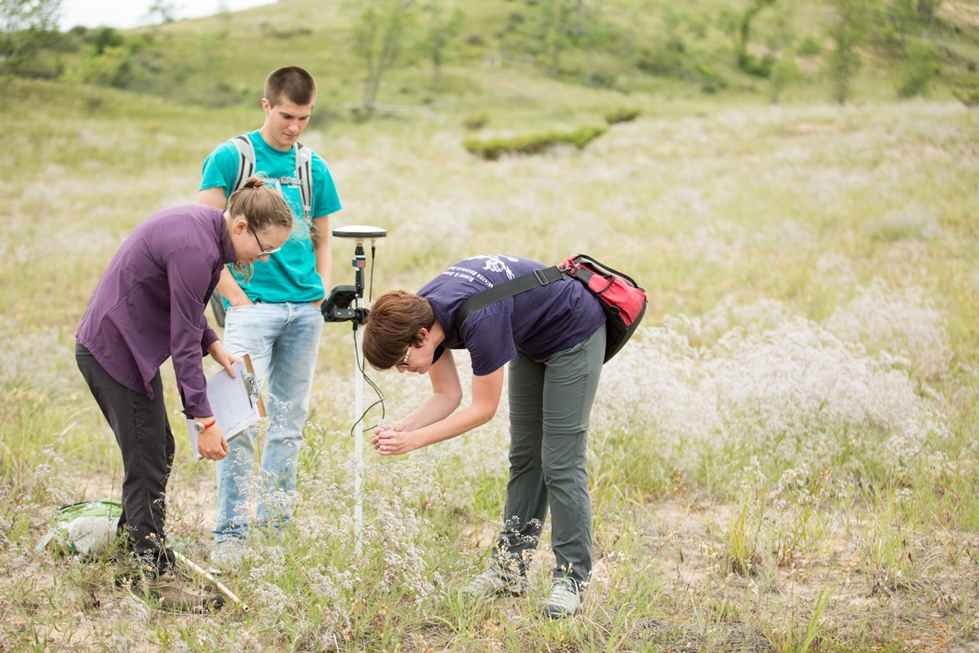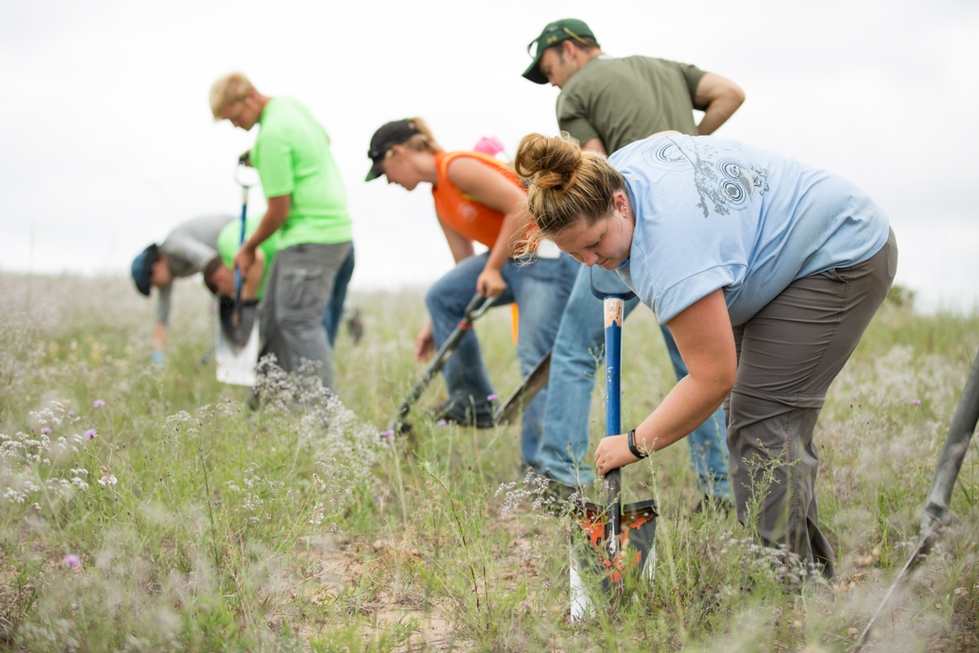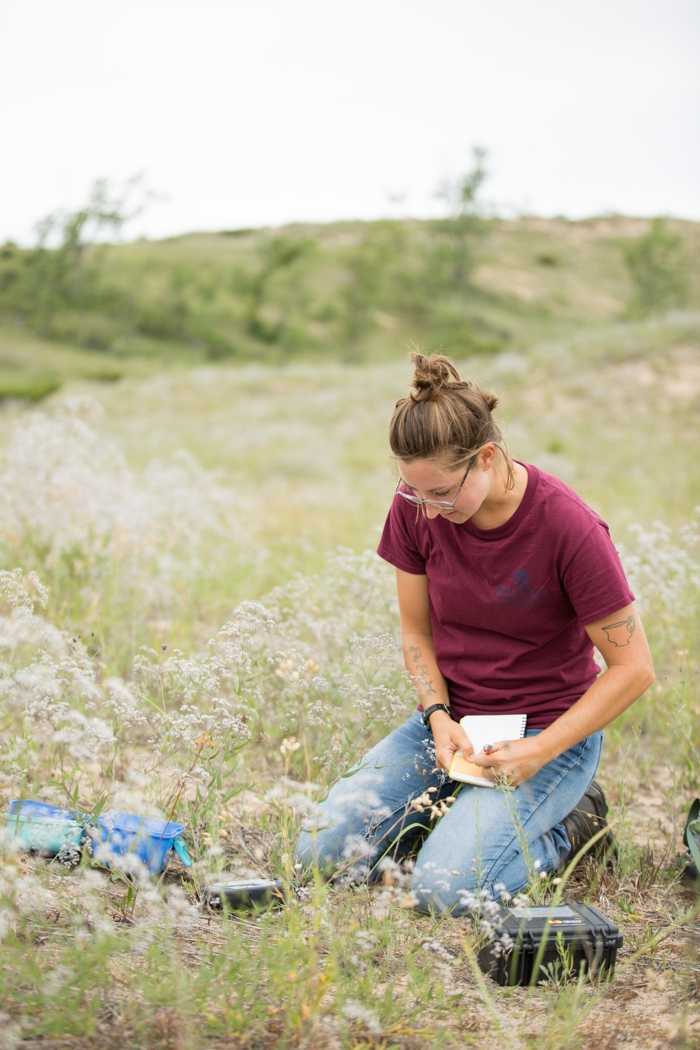Research Fall 2016
Saving Sleeping Bear
Removing an invasive species from Michigan's dune paradise
by Nate Hoekstra
photos by Amanda Pitts
Gypsophila paniculata is a big scientific name for a tiny white flower that is often found in bouquets of roses or ornamental gardens. But the delicate-looking plant known as baby's breath has become a big problem in one of Michigan's most iconic and ecologically significant landscapes.
The plant, which is an invasive species, has rapidly spread and expanded throughout Sleeping Bear Dunes National Lakeshore. A Grand Valley researcher is working to find out how the plant spreads, what will eradicate it, and how to control the population of the plant without harming fragile and federally threatened native plants.
Charlyn Partridge, assistant professor at the Annis Water Resources Institute in Muskegon, along with co-investigators James McNair and Kevin Strychar, is leading the study that she hopes will help protect the world's largest freshwater sand dune system. Partridge said she looks at the issue as an ecological problem as well as an economic one, as the dunes not only provide important habitat for endangered and rare plant species, but because the area is an important economic engine to the tourism industry of northern Michigan.

Charlyn Partridge, right, examines a specimen during a visit to the research site at Sleeping Bear Dunes.
The problem with baby's breath in the national lakeshore is twofold. First, it's incredibly aggressive and outcompetes native vegetation for resources. Second, the seemingly petite and fragile plant has a thick, massive taproot which can extend up to 10 feet deep into the sand, which over-stabilizes the natural shifting of the sands — an ecological process on which many of the native species rely.
Partridge's research has a simple goal: provide data that will help The Nature Conservancy, which has been working to remove baby's breath from the area for a decade, manage the problem more efficiently.
The project is a collaboration between AWRI and The Nature Conservancy, with permission from the National Parks Service, Partridge said.
"We’re trying to add the research perspective to see how well The Nature Conservancy's treatments have been working. Over the years they have qualitatively observed what has been working for them, but we want to put numbers to that," Partridge said.
The research project is based on two methods of testing. The first phase is canvassing the research area, which is about a half mile from the national lakeshore's well-known Pierce Stocking Scenic Drive, and counting how many of the plants are present in each measured research grid area. That quantitative measurement serves as a baseline, from which a series of comparisons can be made.
The hope is to find out whether manually removing the plant by digging it up with a shovel, or killing it by spraying it with Roundup, a herbicide, is the most effective way to get rid of the plant.
Emma Rice, a graduate student at AWRI, is doing a lot of the field work on the quantitative measurement portion of the study.
"We're counting the number of the plants, the percentage of each grid square that's covered by the baby's breath as well as the density," Rice said. "When we come back in the fall and next spring, we'll measure the same areas, see what's there, how it's changed, and which removal methods were the most effective."
Timing is also important in finding the right treatment methods, Rice said. A serious factor is what time of year each method is tested.
"We have to find out if spraying Roundup is most effective in June or July, how early you have to spray to kill the plants before they produce seeds, and if spraying at different times causes the plant to seed early," said Rice.

Workers from the Nature Conservancy use sharp spades to carefully sever the massive baby’s breath taproot during manual plant removal.
Seed control is a critical portion of the study, given that Partridge said each individual baby's breath plant can disperse approximately 14,000 seeds each year, and that the plant has an 80 to 90 percent germination rate.
"That seed distribution and germination make baby's breath extremely competitive," Partridge said. "Once you get an infestation of the plant in an area, it's extremely hard to get rid of. The number of seeds each plant produces is daunting. It's incredibly adaptable. You're in awe and horrified at the same time."
Why baby's breath is problematic
• The invasive species is aggressive and outcompetes native vegetation like the pitcher's thistle. Baby's breath reproduces much more easily and produces thousands more seeds.
• Plant's massive taproot can extend 10 feet deep in sand; this over-stabilizes the natural shifting of the sands.
Two-part research study:
1. Examine area and count plants to find baseline measure. Determine which removal methods are most effective.
2. Use DNA to determine if new plants in the second year are regrowth of previously deposited seeds or if they are traveling by wind from other areas.
Once measurements of which treatments worked well to control regrowth of the plants, the second part of the study takes over, and DNA is used to determine if the new plants in the second year are regrowth of previously deposited seeds or if they are traveling by wind from other areas.
Hailee Pavisich, a graduate student at AWRI, spent the summer collecting leaf samples from baby's breath plants all over western Michigan, which will be used to collect DNA signatures from different populations of the plants. Those signatures will help determine if and how seeds from different populations of plants are traveling from place to place, so removal efforts can be focused on the most important locations.
"I believe that looking at where the populations are coming from is the most important part," Pavisich said. "The end goal of the project is to better inform management of baby's breath, and using genetics and DNA to be able to say definitively where a large majority of seed is coming from will really help with management. Without the DNA testing, the removal process is really guesswork as to the source."

Hailee Pavisich takes a sample that will be used to provide a genetic signature for that specific plant.
The study, which is currently funded by a two-year grant from the Great Lakes Restoration Initiative, is important because it will help understand a particularly invasive species and how it is interacting with the environment, Partridge said.
"It's not just that we don't want it here because it's not a native species, we want to get rid of baby's breath because it's having real detrimental effects on native species in the area," Partridge said.
One plant it's impacting is the federally threatened pitcher's thistle, which is readily outcompeted by the prodigious reproduction of baby's breath. Compared to baby's breath's 14,000 seeds per plant, the pitcher's thistle generally only produces about 50 to 200 seeds. Baby's breath can disperse seeds up to one mile on the wind; pitcher's thistle only distributes seeds in the immediate area of where the flower falls when it dies.
"We need to protect this area and the native species that rely so much on the natural flow of the dunes, and getting rid of this plant is a huge part of protecting that natural ecology," Partridge said. "We are hoping to get funding renewed so we can continue to study this. The problem won't be solved in two years. It's going to take several years of data to get what we need. There is an open book on learning information about this plant, and we'd like to answer a lot of those questions that are still out there."
As a Michigan transplant, Partridge said that she understands the passion Michiganders have for the northern area of the state, and Sleeping Bear in particular.
"It's got a soft spot in my heart," Partridge said. "I have very strong feelings about it. The ecosystem is beautiful and diverse."
The research also illustrates a cautionary tale of invasive species in general, Partridge said.
"Baby's breath is a perfect example of how little we think about some invasive species. Not many people know how invasive it is, and how detrimental it is. You can still buy seeds at the supermarket or garden store. I see it in my neighbor’s gardens," Partridge said. "We need to be very, very careful about planting invasive species in areas where it can widely take over. What we’re seeing in Sleeping Bear is what can potentially happen when we’re not careful."
